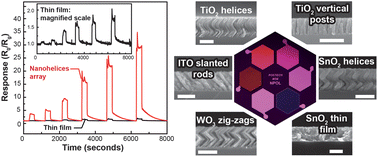Our health and well-being is deeply impacted by the air that we breathe. Maintaining good quality of air is highly dependent on the ability of chemical gas sensors to monitor toxic air pollutants in the environment. While many sensors are currently available, there is still a need for a detection system that is highly sensitive and selective, robust, accurate, fast, adaptable to mass production, and capable of monitoring many different chemical gases. Jong Kyu Kim and colleagues from the Republic of Korea have addressed some of these challenges by developing an “electronic nose” – a series of high performance gas sensors based on an array of TiO2 nanohelices fabricated by the method of rotating oblique angle deposition (OAD).

Gas sensors based on an array of near single crystalline TiO2
Find out more by clicking on the link below:
A near single crystalline TiO2 nanohelix array: enhanced gas sensing performance and its application as a monolithically integrated electronic nose
Sunyong Hwang, Hyunah Kwon, Sameer Chhajed, Ji Won Byon, Jeong Min Baik, Jiseong Im, Sang Ho Oh, Ho Won Jang, Seok Jin Yoon and Jong Kyu Kim
Analyst, 2013, Advance Article
DOI: 10.1039/C2AN35932D










